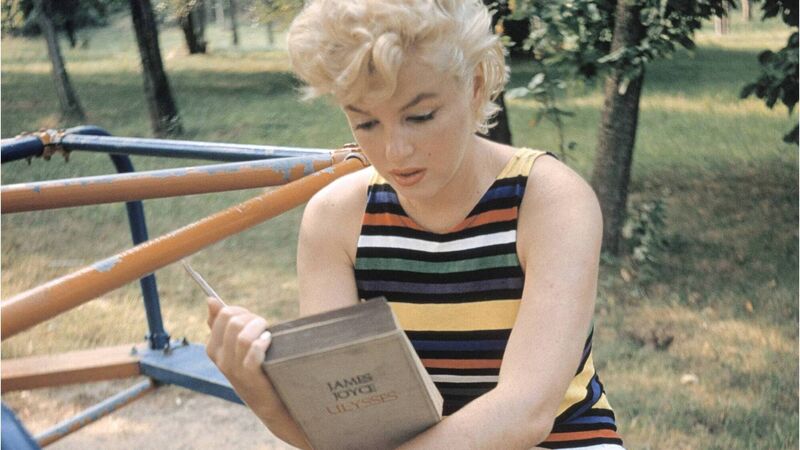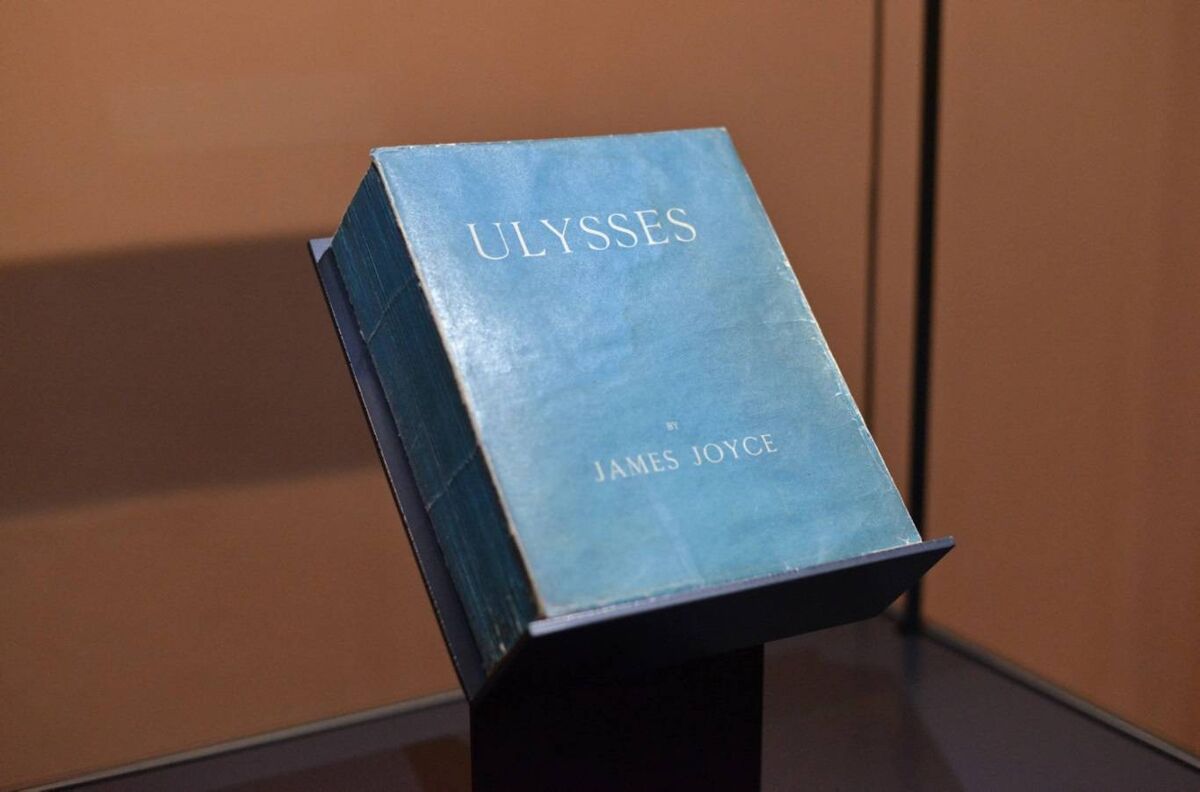How Ulysses by James Joyce signalled a change in the history of literature 100 years ago

Ulysses is not a beach read, despite a photograph of Marilyn Monroe reading it in swimwear. Picture: Eve Arnold/Magnum Pictures
A member of the Royal Irish Constabulary was killed in Killarney by the IRA on February 2, 1922, a month after the passing of the Anglo-Irish Treaty in the Dáil and the establishment of a provisional government to oversee the handover from British rule. It can be seen as marking the beginning of a new wave of violence that would become Ireland’s Civil War.
Earlier in the morning of that same day, a woman named Sylvia Beach stood in the Gare de Lyon in Paris waiting for the arrival of the express train from Dijon. She was not looking for a passenger, but rather the train’s conductor and a package he had been entrusted to carry. It contained two advance copies of James Joyce’s Ulysses, a book for which Sylvia Beach had to borrow and beg the money to pay the printer. It reached her hands just in time for the agreed deadline — the author’s 40th birthday.
James Joyce lived in Paris at the time, and after Beach handed him one wrapped copy in his flat, she placed the other one in the window of her bookshop.
The book’s presence in the window of the Shakespeare and Company bookshop signalled a change in the history of literature, as momentous in its own way as the shooting in Killarney that marked the beginning of a new violent period in Irish history.

People came to gaze at the book in Beach’s bookshop window — its title in white lettering on a bold blue background — because it had already achieved infamy. Ulysses had been partly serialised in a US literary publication until a prosecution for obscenity led to its editors being fined and the magazine burned by the authorities. In 1923 an attempt to import copies of the book into Britain resulted in another mass burning and, although self-censorship made no need for it to be banned in Ireland, it was not easily available in the country until the 1960s.
The book’s history is one of pirated editions, smuggling, scholarly spats, controversies, legal action and, initially, outrage. A UK newspaper warned of its “unclean lunacies”, and an Irish reviewer wrote of its “devilish drench”, advising the Vatican to place it on the Index Expurgatorius so that Catholics would be forbidden to ever read it.
It did not take long for the lambasting to be forgotten and replaced by universal acclaim, however. Joyce’s surviving grandson, Stephen, became very protective over the rights he held to the Joyce estate, a situation that only changed at the start of 2012 when EU law allowed copyright to be lifted 70 years after an author’s death.
The status of Ulysses as a defining work of modernism remains undiminished and the birthday of its first publication is being celebrated around the world. Penguin Classics have released a lovely cloth-bound and compact edition, while Other Press have brought out a gloriously illustrated edition with images by the Spanish artist Eduardo Arroyo. It is a handsome, coffee-table-style book that bears eloquent testimony to the inexhaustible capacity of Ulysses to inspire others.

The artwork in the illustrated edition should help new readers who begin the novel with good intentions but get bogged down in its difficult third chapter. That section could be skipped and it would not be a crime to delay reading the first three chapters entirely, beginning instead with the scene in Leopold Bloom’s house in Eccles St — where the first utterance comes not from a human but a cat (‘Mkgnao!’) — as he prepares breakfast for his wife Molly who is upstairs in bed. The opening chapters can be returned to when the reader wants to know more about the young man, Stephen Dedalus, that Bloom will eventually meet in the National Maternity Hospital in Holles St. The novel’s other significant encounter, Molly Bloom’s assignation with another man, takes place off the page, but it preys on her husband’s mind throughout the day.
Ulysses is not a beach read, despite a photograph of Marilyn Monroe reading it in swimwear, but nor is it forbiddingly impenetrable. Monroe was no ‘dumb blonde’ — the photograph was not a publicity stunt — and she kept the book in her car because she enjoyed reading it. She admitted it was hard going at times, the simple truth being that anyone setting out to read the novel needs a helping hand at times. Sylvia Beach gave Joyce full rein to make changes to the proofs coming from the printer — he had still been receiving corrections at the end of January — and a third of the novel was written this way, adding new layers of meaning and referencing that make it so multifaceted.

The Ireland that Ulysses embodies and gives multiple voices to was a colony of the British Empire, and on the day around which the novel is constructed — June 16, 1904 — the viceroy, representative of British rule, set out on a cavalcade through the capital to inaugurate a bazaar. It was no big deal to most Dubliners, as the novel makes clear, but its presence in Ulysses is just one instance of Joyce’s abiding, anti-imperialist concern with the colonial relationship between Ireland and England and the nationalist politics it gave rise to.
It is the subject of a contender for the single most important book about Ulysses — Joyce’s Revenge by Andrew Gibson — an account, conducted with the precision of a pathologist conducting a post-mortem examination, of how Joyce examined the language of colonial rule and the nationalist response, Ulysses, blending the political with the personal, is also a book about marriage and the famous ‘yes’ at the end of the novel is about how Molly and Leopold Bloom successfully negotiate the sex, secrets, and the sublime side of theirs.
It is also, argues Gibson in Joyce’s Revenge, a looking forward to progressive possibilities opened up by the end of the War of the Independence. Joyce was writing his last chapter in August 1921, just after the truce between the IRA and the British Army. By early the following year, the terms of the Anglo-Irish Treaty had narrowed down the possibilities and Joyce’s hopes were derailed. But, as with all birthdays, the course of what happens afterwards cannot be known, and February 2 was a joyous occasion when Joyce unwrapped his present and saw in print the book he had spent seven years labouring over in Trieste, Zurich, and Paris.
It was, and is now, a time to rejoice.
The centenary of its publication is helpfully producing some guides to the book’s intricacy and wealth of allusions. Just published is Ulysses: A Reader’s Odyssey , by Ireland’s current ambassador to the US, David Mulhall. Having had Irish literature in his diplomatic baggage for four decades, as he puts it, Mulhall is well versed in introducing the book to new readers and his commentaries on the novel’s eighteen episodes are a reassuringly comfortable read. Mulhall’s guide and RTÉ’s faithful dramatization of the novel make a fine way to embark on a reading of Ulysses.
Very helpful also is the map-based guide by Ian Gunn and Clive Hart, now freely available as a pdf. Joyce worked with a map of Dublin and the novel’s geographical accuracy is justly legendary, making the city itself a character in the novel.
Reading Ulysses can become addictive and getting hooked involves consulting second-level guides. There is a new edition of Terence Killeen’s Ulysses Unbound and Sean Sheehan’s Joyce’s Ulysses: A Reader’s Guide. The ultimate guide to the novel’s encyclopaedic details is a scholarly new tome, Annotations to James Joyce’s Ulysses, that will hopefully be available in public libraries while insatiably curious readers of the novel wait for an affordable paperback edition.






